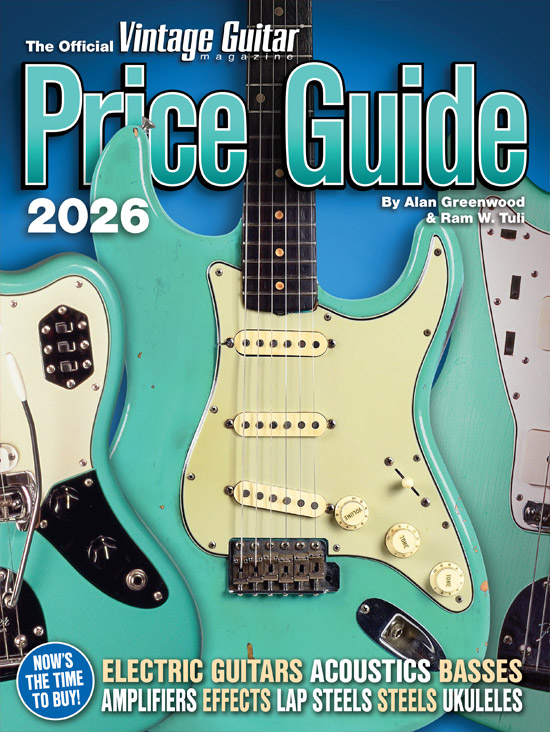
• Preamp tubes: two 12AX7
• Output tubes: one 6V6GT
• Rectifier: 6X4
• Controls: Volume, XTone, tremolo Depth and Rate
• Speakers: 10″ Jensen Alnico P10R in original production models
• Output: approximately 5 watts RMS
When talk amongst vintage-amp aficionados turns to “best-sounding small combos,” bids for the early Fender Princeton or Deluxe, Vox AC15, or Marshall 18-watter are often trumped by the relatively few who have experienced the glories of a DeArmond. But those who know are passionate about the sound of those diminutive creations from northern Ohio.
DeArmond is best known for its pickups of the 1950s and ’60s; the Rhythm Chief 1000 helped amplify many jazz greats of the era, the Model 2000 single-coils (a.k.a. “Dynasonic”) populated Gretsch guitars of the ’50s along with some Guild and Martin electrics, and the “gold foil” pickups supplied to numerous catalog-guitar makers have earned a reputation often well above that of the guitars themselves.
DeArmond’s guitar amps, on the other hand, are far less known, yet guitarists who have spent quality time with them often concede that they’re the finest gear ever produced by the company.

In May of 2014, we profiled the ’61 Martin 112T – a re-badged DeArmond R15T which, behind either brand name, is acclaimed by many as the best-sounding small combo ever made. And the perplexing thing is that it ousted late-’50s Fenders from the top slot even while sporting a circuit and overall design that looks very much like it; a few different signal capacitors, larger transformers, and a hotter preamp tube in the first position all add up to a better-sounding 15-watt 1×12″ (the R15T’s tremolo is a bonus, but the same applies to the tremolo-less R15). All of this made a DeArmond R15T/Martin 112T a great find on the vintage market before the word was out, and either rendition will now likely cost you as much or more than its erstwhile (and formerly more-collectible) Fender rival.
Enter the R15T’s smaller brother, the R5T. A few years ago, vintage-amp enthusiast Leon Chalnick was yet another guitarist in search of the amp everyone suddenly wanted, when a respected authority on vintage guitar tone steered him in an alternative direction.
“I’m not normally into single-ended amps, so the R5T was not an amp that I thought I’d be interested in,” Chalnick says. “I was, however, interested in its well-known and highly respected big brothers, the R15 and R15T. I’d been inquiring about these amps and got into a discussion with renowned guitarist Steve Kimock (see “Classics” in the May ’24 issue), who shared his thoughts and experiences with DeArmond amps, and told me that in his opinion, while the R15s were great-sounding, the little single-ended R5T had the real magic. So, I set about looking for one.”
DeArmond pickups, amplifiers, effects, and accessories were made by Rowe Industries, in Toledo, with the peak of the collaboration stretching from around 1940 to the late ’60s. Harry DeArmond and Bud Rowe were both born in 1906, 550 miles apart in Clinton, Kentucky, and Toledo, respectively. DeArmond’s proficiency on guitar, banjo, and piano took him north, where he played in several bands, while his design and electronics prowess caught the attention of the young entrepreneur Rowe, who was trained in the broader applications of consumer electronics. DeArmond signed on as a consultant with Rowe Industries in the mid ’30s, and in 1941 the pair put their names on what is widely recognized as the first stand-alone effects unit for guitar and other amplified instruments, the Tremolo Control.

For all the great products designed by DeArmond and manufactured by Rowe in the decades that followed, the amplifiers are among some of the best-sounding, thanks to Harry DeArmond’s finely-tuned ears. And as touched upon above, there’s minor enigma attached to this consensus since the R15T and R5T are perhaps 90 percent similar to their Fender counterparts in design and features. Yet, as any clued-in tonesmith will acknowledge, everything makes a difference, and often it’s the handful of minor alterations that really push a design over the top.
Chalnick, who has worked on his own vintage amps for many years, has his own thoughts on what makes the R5T special.
“The R5T design is simple enough,” he said. “The one unusual thing about the circuit is the 650k Tone pot, which is damn near impossible to find nowadays! I’m not sure how much of an impact it really has. And, not only is the 6X4 an unusual rectifier tube, but the design employs a 500-Ohm, five-watt resistor before the first filter cap, which is also unusual. It also has a little bit more robust filtering than a Champ, starting out with a 40-uF electrolytic filter cap. Those design elements do contribute to the very robust sound of this amp.
“Then there are two special things about the way the amp was designed and built. First, the power and output transformers are substantial for such a small amp. Second, by building a larger cab and putting a 10″ speaker in it rather than an 8”, like a Champ, you wind up with a much bigger, much more natural guitar sound, with much better low-end.”

As required to keep most older tube amps functional, Chalnick replaced some filter and signal capacitors in the R5T, and replaced the unidentifiable (and under-powered) original speaker with a suitable modern 10″. In addition, he likes to run the amp with a 6L6 output tube rather than the single 6V6 it was designed for.
“There may be a primary-impedance mismatch, but it’s not vast, and the amp really sounds great with it,” he noted. “I’ve had three other R5Ts come across my bench, and all sounded better with 6V6s. So, who knows?”
One other interesting anomaly regarding this R5T is that it appears to have been built some years after the original run. Most records indicate Rowe manufactured them in 1960-’61 (which is why we have dated this as such elsewhere), but this one carries a power transformer dated ’64, along with some oddities in the layout of the chassis holes and a few other non-standard details, yet all apparently factory original. Given the rough-and-ready “homebrew” nature of some Rowe/DeArmond creations, it’s not inconceivable that this amp was cobbled from leftover components and whatever else was available – none of which curtails the mighty sound emanating from its small package.
This article originally appeared in VG’s June 2024 issue. All copyrights are by the author and Vintage Guitar magazine. Unauthorized replication or use is strictly prohibited.



